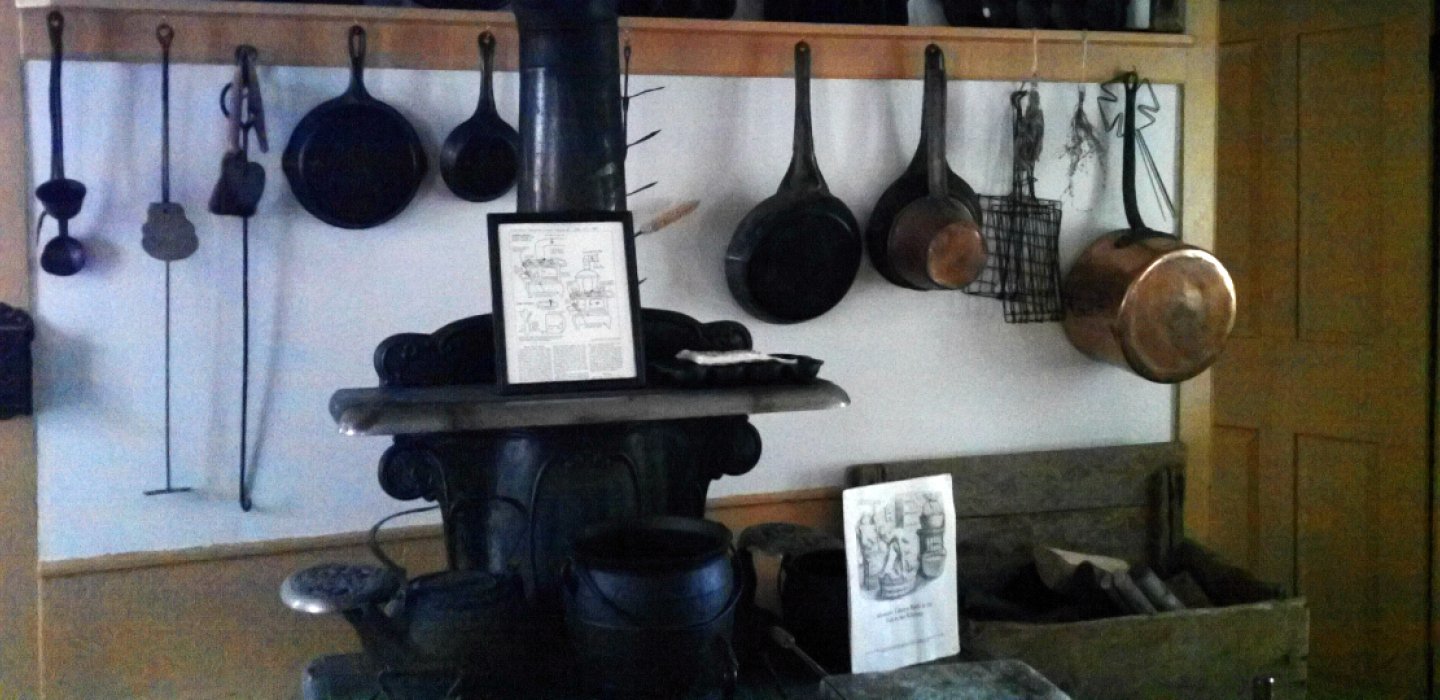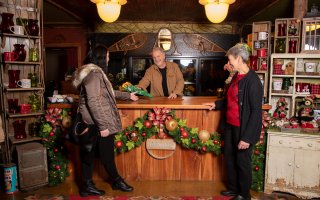
I find the logistics of Thanksgiving dinner to be daunting even with modern conveniences. I can only imagine the level of difficulty using a woodburning stove like the one seen above from the Almanzo Wilder Homestead. Something to think about the next time someone talks about the glories of an "old fashioned" Thanksgiving. Just how old fashioned are they willing to go?
But then, these incredible ladies had the advantage of long experience and lots of practice. So when I managed to track down an authentic Malone Cook Book from 1917, I became fascinated by what Thanksgiving dinner recipes they would have followed.

the bird
Legend has it that the turkey was a part of the First Thanksgiving. Many historians note that turkey became a festive holiday centerpiece from 1843, when "A Christmas Carol" became an international bestseller. This turned many of the practices described by the author, Charles Dickens, into iconic must-haves.
There were also practical reasons for poultry popularity, as a farmer could get a few turkey chicks in the spring and let them run around the farmyard feeding themselves. By harvest time they would be around ten pounds: a good size for the ovens, and heating materials, of the time. They were also not an animal who continued to give service, such as a cow or sheep, and were well-suited as a planned celebration.
Here is Mrs. Belding's recipe for roast turkey:
To Roast a Turkey. -- For a ten-pound turkey, singe, draw, wash, and dry the turkey. Prepare a dressing of sifted bread crumbs. Season well with salt, pepper, and sage, moisten with melted butter. Stuff the turkey and rub a little salt on outside. Put in a dripping pan with a cup of water and roast from three to four hours basting frequently.
If you are like me, who once called a relative to find out how to cook a canned ham, this is entirely too little information. But that "singe" instruction means just that, as I discovered upon cooking my own first Thanksgiving dinner. I slid this giant turkey out of its wrappings and was horrified to see what looked like the hair on a cartoon baby. My husband said we had to burn the hairs off with a blowtorch. And he did.
"Draw" is taking out the insides, or giblets, which were probably not, I'm guessing, nicely packaged inside the bird. Do search very well. Don't ask me how I know.
A "dripping pan" is a shallow pan, sometimes with a rack to hold the roasted meat above the drippings. I think the cup of water goes in the pan, for moistness and to have something to baste with. "Roast" would have been a well-known oven temperature that every aspiring cook would already know.
Basting is such a tedious chore that they would have been open to a way of avoiding it. Because there's two whole pages devoted to details of Paper Bag Cookery.

It is introduced as "M. Soyer's method" which must refer to the 1911 book, "Soyer's Paper-Bag Cookery" by Nicolas Soyer. Per the publisher:
Paper-Bag Cookery has made a great furor in England, and the English press have everywhere given it the attention it deserves. It already has hosts of adherents. The method fully merits all that has been said in its favor. On account of its cleanliness, it is hygienic; because of the conservation of flavors which it permits, it tempts the appetite and makes food palatable; because of the lack of waste connected with it, it is the most economical mode of cookery, a consideration which cannot be ignored in this day of high prices. For all these reasons there is no doubt that, when M.Soyer's method is once understood, it will be eagerly adopted by housewives and cooks all over the country. It is, moreover, so simple that it can be easily learned by the veriest tyro in the culinary art.
What cook could resist! However, with modern methods such as more heat-proof oven bags, pop-up timers, and self-basting, it does seem that we actually have advanced our game over the century since.
the sides
When was the concept of the relish tray invented? I found an 1871 menu from the Malone Palladium hotel which mentioned a dish of "olives and celery" which was part of the appetizers. So it wasn't just Grandma who got out the compartmented dish for such treats, nor was it solely to keep hungry kids amused and somewhat satiated. Once molded glass was invented in 1825, glassmakers quickly found that every hostess wanted a fancy dish to put celery, olives, and other pickled items on display.
One 1847 cookery book advised that turkey should be accompanied by "mashed potatoes and turnips, boiled onions and dressed celery, or other salad with apple sauce." But during further investigation, one dish stood out: the creamed chestnuts.

Here is the recipe:
Creamed Chestnuts. -- Shell and blanch chestnuts, and cook in boiling water till tender. Drain, and add an equal measure of cream sauce.
The cream chestnuts may be sprinkled with grated cheese, covered with buttered crumbs, and browned in the oven.
What is the recipe for cream sauce? Not in the book. Apparently this is like boiling water: everyone was expected to know it! Then again, many of the recipes for creamed vegetables are: "boil, drain, mash, add one cup of cream slightly thickened with flour." Except peas. There's really no point to mashing peas. Page after page goes on this way, indicating that diners of the time did not believe in recognizing the vegetables once they reached the table.
1917 is another significant date for the Thanksgiving dinner; it was the year the Angelus Marshmallows company handed out a recipe booklet which included the classic pairing of sweet potatoes (new to Northern tables in the last half of the 19th century) and marshmallows. These were not unknown to the ladies of Malone, since Mrs. Leslie Lathrop included them in her recipe for Pineapple and Marshmallow salad. But their greatest triumph was apparently yet to come.
Judging from the good ladies of 1917, they were busy enough without the extravaganza of multiple side dishes that characterize the modern Thanksgiving dinner. Then again, they were also busy making pies.
the desserts
Of course, we have to consider the importance of dessert. That item we must leave room for. One early tradition is one I can't believe anyone let drop off the roster: Marlborough Pie.

Take it away, Mrs. Botham:
Marlborough Pie. -- Six tablespoons each of stewed apple, and sugar, one whole egg and yolks of two, one-half cup of sweet cream and a little cinnamon. Stir together and pour into a crust and bake. Frost with the white of two eggs and two tablespoons of sugar.
How long? What temperature? Mrs. Botham expects you to know such things!
Though actual measurements are a soothing addition; colonial era cookbooks were fond of such things as "a lump of butter the size of a walnut" and "enough flour to balance on the thumb," and indeed, Mrs. R.N. Porter still uses such descriptions in her contributions.
In mid-19th century mincemeat pies ("enough to serve every member of the party") were The Law; while by 1917 these pies, made with actual meat, of course, were no longer in fashion. This must have been still a hotly contested issue, judging by the four mincemeat recipes, from Mrs. Sidney S. Whittelsey, Mrs. Spann, Mrs. St. T. Carpenter, and Mrs. O. S. Lawrence.
As early as 1869 pumpkin pie had ascended to Must Have status on holiday tables. Maggie O'Connor contributed a recipe heavy on the pumpkin and spice, while Ida Mitchell preferred a deep dish version heavy on the cream. A Miss Parloa jumped into the controversy (which continues to this day) by throwing in her recipe for Sweet Potato Pie, with nutmeg instead of ginger.
These ladies take their pie seriously. Sandwich fillings take up two and half pages, but the recipes for pies covers nine and a half pages.
I love these ladies.
Whatever the family must have favorites, I wish you a lovely Thankgiving celebration!
Explore all the dining options. Find a place to put your feet up and loosen your belt. Get ready for some shopping! And the First Congregational Church is still here and still lovely. Discover it with the Malone Historical Walking Tour.
The Malone Cook Book is available as a free download on the Internet. Enjoy!
This week in Indulgent ADK news:
Ditching the kid for drinks & crepes.






Comments
Add new comment